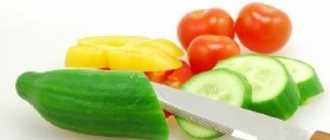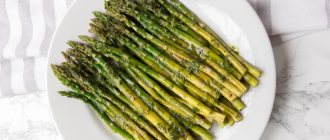Starchy and non-starchy vegetables - table
Starchy vegetables contain starch, which is converted during digestion into glucose, which is the most common form of polysaccharides in nature.
Therefore, the division of vegetables into starchy and non-starchy, which was originally part of the theory of separate nutrition, has found a place in a universal healthy diet.
Non-starchy vegetables are real helpers in losing weight, but you should be careful with starchy ones!
But how not to get confused? A table with a list will help you choose the healthiest vegetables for yourself.
Are foods containing starch an indication of whether there are many fast carbohydrates in your diet?
As you know, excess fast carbohydrates in the diet contribute to weight gain, and if you pay close attention to their quantity, then you will be able to regulate the caloric content of your diet.
When losing weight, it is always recommended to eat low-starch vegetables, but how do you know whether vegetables are starchy or non-starchy?
Non-starchy vegetables are high in nutrients but low in calories
Non-starchy vegetables contain very few calories - only 15-30 calories per 70-90 grams (, ,).
For this reason, you can eat large portions of non-starchy vegetables without consuming excess calories.
They are also about 90-95% water, making them a good source of fluid in your diet. Therefore, non-starchy vegetables can help you meet your daily fluid needs (, ,).
Although low in calories, non-starchy vegetables are high in fiber and contain essential vitamins and minerals. In fact, they contain small amounts of almost every vitamin and mineral you need.
Additionally, non-starchy vegetables are low in carbohydrates, with only 4-6 grams of carbohydrates per 70-90 gram serving. As a result, they have little effect on blood sugar levels and are suitable for people with diabetes who are on a low-carb diet (,).
It is best to eat a variety of non-starchy and starchy vegetables throughout the day. They add color, nutrients and flavor to your dishes, and only a negligible amount of calories.
Summary:
Non-starchy vegetables are very low in calories and contain a lot of water. Despite this, they have an impressive nutrient profile and provide your body with almost all the vitamins and minerals you need.
The starchiest vegetables
The highest percentage of starch content is found in root vegetables and large grains, which accumulate nutrients to continue growth and provide a “food supply” for the plant embryo.
It is believed that the champion in starch content is potatoes, but this is not entirely true; it contains from 16-18%.
In processed form, in the form of chips and fries, there is more starch. And in boiled potatoes and mashed potatoes - 11 -14%
The recommendations of nutritionists are quite strict - eat less potatoes, but they do not recommend giving up altogether. Therefore, everything needs moderation and a reasonable amount. Excess of any food, as well as overeating, will always lead to weight gain.
What to eat starchy vegetables with?
It is recommended to consume starchy vegetables, if at all, then only in combination with green non-starchy vegetables, fats (both vegetable and animal), avoiding the gastronomic tandem with proteins, sugar and acid.
The rule is: one meal - one type of starchy vegetables.
Non-starchy vegetables are the basis of the menu for weight loss!
The products from this list go well with all types of starchy and protein foods, are perfectly digestible and do not create any problems for the gastrointestinal tract or waist.
Milk is the only undesirable companion for non-starchy vegetables, and you should avoid not only regular whole milk, but also sauces based on it (such as bechamel).
The founder of separate nutrition, Herbert Shelton, classified cauliflower as a moderately starchy vegetable, on the one hand, in terms of compatibility and dietary properties, classifying it among its non-starchy counterparts, and on the other, noting that, nevertheless, you should eat a little cauliflower, and better together with fats.
Shelton's followers have expanded the list of moderately starchy vegetables, adding new participants who, although they contain starch, are not in criminal quantities.
Please note that eggplant, in different interpretations, can also refer to both non-starchy and moderately starchy vegetables. (see tables below).
The tomatoes, adored by many, on which the popular tomato diet is based, have not found a place either among starchy or non-starchy vegetables, although in the popular imagination this is the most salad vegetable (though from a botanical point of view, a tomato is a berry).
Shelton found that the main thing in the nutritional characteristics of a tomato is its acidity, and not its starch content.
Due to the high percentage of citrus, malic and oxalic acids in their composition, red-cheeked tomatoes are an acidic food and cannot be eaten with anything starchy, but they can be eaten with leafy vegetables and fats.
Using the lists, you can easily navigate the variety of vegetables, choosing effective products for losing weight and staying in shape.
But I would like to say a few words in defense of starch











